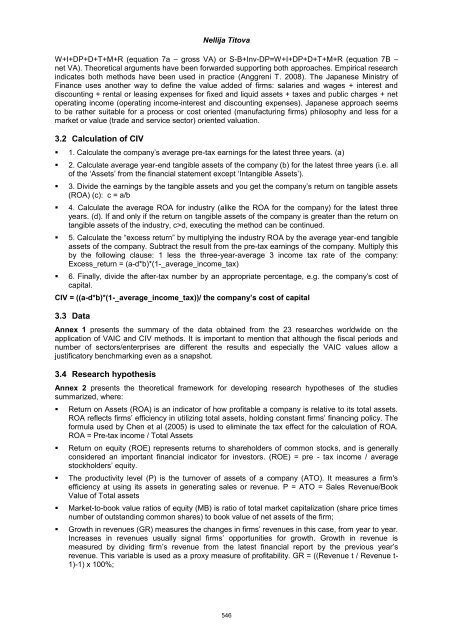Proceedings of the 3rd European Conference on Intellectual Capital
Proceedings of the 3rd European Conference on Intellectual Capital
Proceedings of the 3rd European Conference on Intellectual Capital
Create successful ePaper yourself
Turn your PDF publications into a flip-book with our unique Google optimized e-Paper software.
Nellija Titova<br />
W+I+DP+D+T+M+R (equati<strong>on</strong> 7a – gross VA) or S-B+Inv-DP=W+I+DP+D+T+M+R (equati<strong>on</strong> 7B –<br />
net VA). Theoretical arguments have been forwarded supporting both approaches. Empirical research<br />
indicates both methods have been used in practice (Anggreni T. 2008). The Japanese Ministry <str<strong>on</strong>g>of</str<strong>on</strong>g><br />
Finance uses ano<str<strong>on</strong>g>the</str<strong>on</strong>g>r way to define <str<strong>on</strong>g>the</str<strong>on</strong>g> value added <str<strong>on</strong>g>of</str<strong>on</strong>g> firms: salaries and wages + interest and<br />
discounting + rental or leasing expenses for fixed and liquid assets + taxes and public charges + net<br />
operating income (operating income-interest and discounting expenses). Japanese approach seems<br />
to be ra<str<strong>on</strong>g>the</str<strong>on</strong>g>r suitable for a process or cost oriented (manufacturing firms) philosophy and less for a<br />
market or value (trade and service sector) oriented valuati<strong>on</strong>.<br />
3.2 Calculati<strong>on</strong> <str<strong>on</strong>g>of</str<strong>on</strong>g> CIV<br />
1. Calculate <str<strong>on</strong>g>the</str<strong>on</strong>g> company‟s average pre-tax earnings for <str<strong>on</strong>g>the</str<strong>on</strong>g> latest three years. (a)<br />
2. Calculate average year-end tangible assets <str<strong>on</strong>g>of</str<strong>on</strong>g> <str<strong>on</strong>g>the</str<strong>on</strong>g> company (b) for <str<strong>on</strong>g>the</str<strong>on</strong>g> latest three years (i.e. all<br />
<str<strong>on</strong>g>of</str<strong>on</strong>g> <str<strong>on</strong>g>the</str<strong>on</strong>g> „Assets‟ from <str<strong>on</strong>g>the</str<strong>on</strong>g> financial statement except „Intangible Assets‟).<br />
3. Divide <str<strong>on</strong>g>the</str<strong>on</strong>g> earnings by <str<strong>on</strong>g>the</str<strong>on</strong>g> tangible assets and you get <str<strong>on</strong>g>the</str<strong>on</strong>g> company‟s return <strong>on</strong> tangible assets<br />
(ROA) (c): c = a/b<br />
4. Calculate <str<strong>on</strong>g>the</str<strong>on</strong>g> average ROA for industry (alike <str<strong>on</strong>g>the</str<strong>on</strong>g> ROA for <str<strong>on</strong>g>the</str<strong>on</strong>g> company) for <str<strong>on</strong>g>the</str<strong>on</strong>g> latest three<br />
years. (d). If and <strong>on</strong>ly if <str<strong>on</strong>g>the</str<strong>on</strong>g> return <strong>on</strong> tangible assets <str<strong>on</strong>g>of</str<strong>on</strong>g> <str<strong>on</strong>g>the</str<strong>on</strong>g> company is greater than <str<strong>on</strong>g>the</str<strong>on</strong>g> return <strong>on</strong><br />
tangible assets <str<strong>on</strong>g>of</str<strong>on</strong>g> <str<strong>on</strong>g>the</str<strong>on</strong>g> industry, c>d, executing <str<strong>on</strong>g>the</str<strong>on</strong>g> method can be c<strong>on</strong>tinued.<br />
5. Calculate <str<strong>on</strong>g>the</str<strong>on</strong>g> “excess return” by multiplying <str<strong>on</strong>g>the</str<strong>on</strong>g> industry ROA by <str<strong>on</strong>g>the</str<strong>on</strong>g> average year-end tangible<br />
assets <str<strong>on</strong>g>of</str<strong>on</strong>g> <str<strong>on</strong>g>the</str<strong>on</strong>g> company. Subtract <str<strong>on</strong>g>the</str<strong>on</strong>g> result from <str<strong>on</strong>g>the</str<strong>on</strong>g> pre-tax earnings <str<strong>on</strong>g>of</str<strong>on</strong>g> <str<strong>on</strong>g>the</str<strong>on</strong>g> company. Multiply this<br />
by <str<strong>on</strong>g>the</str<strong>on</strong>g> following clause: 1 less <str<strong>on</strong>g>the</str<strong>on</strong>g> three-year-average 3 income tax rate <str<strong>on</strong>g>of</str<strong>on</strong>g> <str<strong>on</strong>g>the</str<strong>on</strong>g> company:<br />
Excess_return = (a-d*b)*(1-_average_income_tax)<br />
6. Finally, divide <str<strong>on</strong>g>the</str<strong>on</strong>g> after-tax number by an appropriate percentage, e.g. <str<strong>on</strong>g>the</str<strong>on</strong>g> company‟s cost <str<strong>on</strong>g>of</str<strong>on</strong>g><br />
capital.<br />
CIV = ((a-d*b)*(1-_average_income_tax))/ <str<strong>on</strong>g>the</str<strong>on</strong>g> company’s cost <str<strong>on</strong>g>of</str<strong>on</strong>g> capital<br />
3.3 Data<br />
Annex 1 presents <str<strong>on</strong>g>the</str<strong>on</strong>g> summary <str<strong>on</strong>g>of</str<strong>on</strong>g> <str<strong>on</strong>g>the</str<strong>on</strong>g> data obtained from <str<strong>on</strong>g>the</str<strong>on</strong>g> 23 researches worldwide <strong>on</strong> <str<strong>on</strong>g>the</str<strong>on</strong>g><br />
applicati<strong>on</strong> <str<strong>on</strong>g>of</str<strong>on</strong>g> VAIC and CIV methods. It is important to menti<strong>on</strong> that although <str<strong>on</strong>g>the</str<strong>on</strong>g> fiscal periods and<br />
number <str<strong>on</strong>g>of</str<strong>on</strong>g> sectors/enterprises are different <str<strong>on</strong>g>the</str<strong>on</strong>g> results and especially <str<strong>on</strong>g>the</str<strong>on</strong>g> VAIC values allow a<br />
justificatory benchmarking even as a snapshot.<br />
3.4 Research hypo<str<strong>on</strong>g>the</str<strong>on</strong>g>sis<br />
Annex 2 presents <str<strong>on</strong>g>the</str<strong>on</strong>g> <str<strong>on</strong>g>the</str<strong>on</strong>g>oretical framework for developing research hypo<str<strong>on</strong>g>the</str<strong>on</strong>g>ses <str<strong>on</strong>g>of</str<strong>on</strong>g> <str<strong>on</strong>g>the</str<strong>on</strong>g> studies<br />
summarized, where:<br />
Return <strong>on</strong> Assets (ROA) is an indicator <str<strong>on</strong>g>of</str<strong>on</strong>g> how pr<str<strong>on</strong>g>of</str<strong>on</strong>g>itable a company is relative to its total assets.<br />
ROA reflects firms‟ efficiency in utilizing total assets, holding c<strong>on</strong>stant firms‟ financing policy. The<br />
formula used by Chen et al (2005) is used to eliminate <str<strong>on</strong>g>the</str<strong>on</strong>g> tax effect for <str<strong>on</strong>g>the</str<strong>on</strong>g> calculati<strong>on</strong> <str<strong>on</strong>g>of</str<strong>on</strong>g> ROA.<br />
ROA = Pre-tax income / Total Assets<br />
Return <strong>on</strong> equity (ROE) represents returns to shareholders <str<strong>on</strong>g>of</str<strong>on</strong>g> comm<strong>on</strong> stocks, and is generally<br />
c<strong>on</strong>sidered an important financial indicator for investors. (ROE) = pre - tax income / average<br />
stockholders‟ equity.<br />
The productivity level (P) is <str<strong>on</strong>g>the</str<strong>on</strong>g> turnover <str<strong>on</strong>g>of</str<strong>on</strong>g> assets <str<strong>on</strong>g>of</str<strong>on</strong>g> a company (ATO). It measures a firm's<br />
efficiency at using its assets in generating sales or revenue. P = ATO = Sales Revenue/Book<br />
Value <str<strong>on</strong>g>of</str<strong>on</strong>g> Total assets<br />
Market-to-book value ratios <str<strong>on</strong>g>of</str<strong>on</strong>g> equity (MB) is ratio <str<strong>on</strong>g>of</str<strong>on</strong>g> total market capitalizati<strong>on</strong> (share price times<br />
number <str<strong>on</strong>g>of</str<strong>on</strong>g> outstanding comm<strong>on</strong> shares) to book value <str<strong>on</strong>g>of</str<strong>on</strong>g> net assets <str<strong>on</strong>g>of</str<strong>on</strong>g> <str<strong>on</strong>g>the</str<strong>on</strong>g> firm;<br />
Growth in revenues (GR) measures <str<strong>on</strong>g>the</str<strong>on</strong>g> changes in firms‟ revenues in this case, from year to year.<br />
Increases in revenues usually signal firms‟ opportunities for growth. Growth in revenue is<br />
measured by dividing firm‟s revenue from <str<strong>on</strong>g>the</str<strong>on</strong>g> latest financial report by <str<strong>on</strong>g>the</str<strong>on</strong>g> previous year‟s<br />
revenue. This variable is used as a proxy measure <str<strong>on</strong>g>of</str<strong>on</strong>g> pr<str<strong>on</strong>g>of</str<strong>on</strong>g>itability. GR = ((Revenue t / Revenue t-<br />
1)-1) x 100%;<br />
546
















